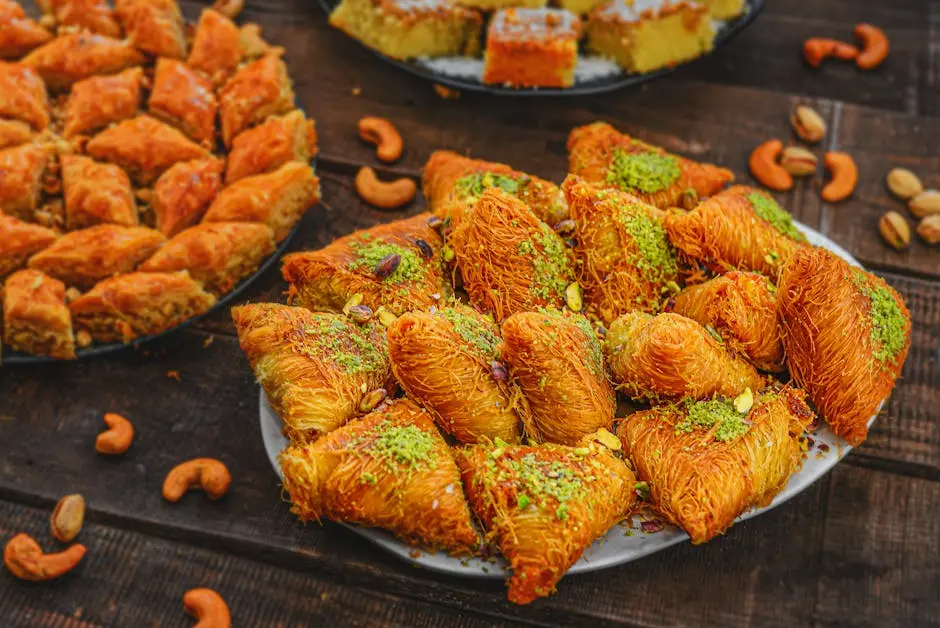
What Ingredients Make Middle Eastern Desserts Unique?
Middle Eastern desserts are not just sweet treats; they hold a rich cultural heritage in every bite. What makes these desserts so distinctive? The ingredients! In this blog, we’ll explore the key ingredients that contribute to the unique flavors and textures of Middle Eastern desserts. From aromatic spices to textures that delight the palate, let’s dive in.
Key Ingredients to Explore
Starting with the essentials, we’ll discuss the most common ingredients that define Middle Eastern desserts.
Flour is a foundational ingredient, with variations like all-purpose, semolina, or rice flour bringing unique textures. In desserts like baklava and kunafa, these flours create the ideal base that complements rich fillings.
Additionally, sugar is often used, but specialty syrups like rosewater or orange blossom water elevate the sweetness, imparting floral notes that dance on the palate.
Together, these ingredients form the backbone of Middle Eastern desserts, setting the stage for flavor innovation.
The Role of Nuts
Nuts are a staple in many Middle Eastern desserts. Here, we’ll examine their flavor and textural contributions.
Almonds, pistachios, and walnuts not only provide crunch but also introduce layers of flavor that enhance dishes like baklava or maamoul. Their natural oils add a richness that balances the sweetness beautifully.
When toasted, these nuts release their oils and intensify their flavor. Imagine the satisfying crunch of a finely chopped nut layer beautifully juxtaposed against soft pastry or creamy fillings.
Moreover, nuts can often be ground into flour, further diversifying the dessert landscape. This ensures that each bite of a Middle Eastern treat is packed with nutty goodness.
Spices that Set the Scene
Spices like cardamom and cinnamon add warmth and depth to desserts. Let’s see how they enhance sweetness.
Cardamom, often referred to as the ‘queen of spices,’ lends a unique aroma that elevates dishes like rice pudding and zalabia. A touch can transform a simple dessert into a culinary masterpiece.
Cinnamon, on the other hand, weaves its way into many treats, offering comforting warmth that blends seamlessly with chocolate or creamy components. Together with other spices, they create a symphony of flavors that celebrates the essence of Middle Eastern cuisine.
The use of spices reflects the historical trade routes and cultural exchanges in the region, making each dessert not just a recipe but a story.
Natural Sweeteners and Their Impact
Unlike refined sugars, Middle Eastern desserts often use honey and date syrup. We’ll learn how these sweeteners change the flavor profile.
Honey, with its floral notes, enhances the inherent flavors of the ingredients. In delicate pastries, it binds components together while adding a natural sweetness that is less cloying than processed sugars.
Date syrup, thick and rich, brings a distinct caramel-like flavor that pairs wonderfully with nuts and grains in desserts such as date ma’amoul or harissa.
These natural sweeteners not only enrich the taste but also provide health benefits, making them a beloved choice in Middle Eastern kitchens across the globe.
The Importance of Dairy
Dairy ingredients like yogurt and cream are essential for many recipes. Let’s explore their role in creating creamy textures.
Rich, creamy ingredients lend their character to desserts like knafeh and muhalabia, where smoothness is key. Yogurt can also add a tangy element, balancing sweetness perfectly.
Cream is often used to enrich syrups and fillings, providing a luscious mouthfeel that enhances the overall dessert experience.
The combination of dairy with other ingredients gives Middle Eastern desserts their signature richness, making every bite a comforting delight.
Unique Grains and Flours
From semolina to rice flour, the grains used in Middle Eastern desserts influence the overall experience. We’ll discuss their uses.
Semolina, known for its coarse texture, is favored in puddings and cakes, providing a dense but flavorful base that absorbs syrups beautifully. This grain is instrumental in dishes like basbousa.
Rice flour, glutinous or non-glutinous, finds its way into desserts like rice pudding and various pastries, imparting a unique chewiness and soft texture.
The choice of grain not only affects texture but also flavor, showcasing the incredible diversity found in Middle Eastern dessert culture.
Unique Fruits for Freshness
Fruits such as pomegranates and citrus not only add flavor but also a burst of freshness. Here’s how they’re incorporated.
Pomegranate seeds provide a juicy crunch and stunning color, livening up dishes like rice puddings or fruit salads. Their tartness balances the sweetness and adds complexity to the taste.
Citrus fruits, including oranges and lemons, offer zesty brightness that awakens the palate, especially in desserts like maamoul or sweet pastries drizzled with syrup.
These fruits play a vital role, not only adding freshness but also showcasing the bounty of the region, ensuring that each dessert is as vibrant as it is delicious.
Satisfy Your Sweet Tooth with Authentic Flavors
The ingredients used in Middle Eastern desserts combine tradition with flavor, creating treats that are not only delicious but also deeply rooted in history. By understanding these elements, you can appreciate the artistry behind each dessert and perhaps even try to recreate them in your own kitchen.
